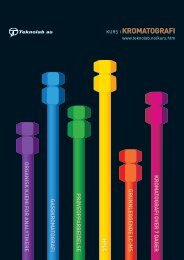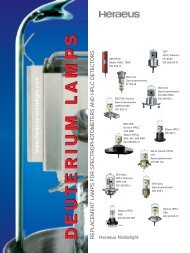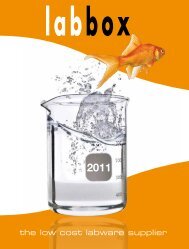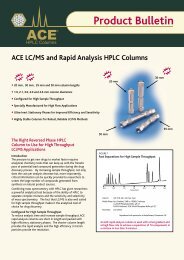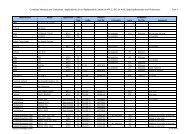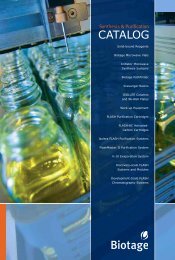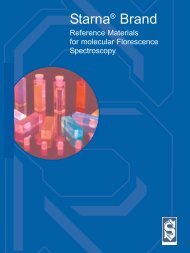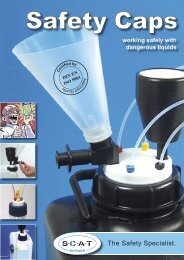PDF catalog - Teknolab AS
PDF catalog - Teknolab AS
PDF catalog - Teknolab AS
You also want an ePaper? Increase the reach of your titles
YUMPU automatically turns print PDFs into web optimized ePapers that Google loves.
TO<br />
QUICKSTART GUIDE TO SPE<br />
Step 6:<br />
Analyte Elution<br />
A good elution solvent should elute the analyte in as low a volume as possible. Choose a solvent or solvent<br />
mixture in which the analyte is highly soluble. Elution solvents should overcome both primary and any secondary<br />
interactions by which the analyte is retained.<br />
Table 3 provides some useful guidelines on the choice of analyte elution solvents.<br />
During method development, it is important to evaluate the effect of different flow rates on the efficiency of<br />
analyte elution, and specify the optimum flow rate range in the protocol. Lower flow rates are often required<br />
for ion exchange sorbents. It is sometimes useful to elute the analyte with two aliquots of X/2 mL of solvent,<br />
rather than a single elution step with X mL solvent.<br />
Where basic analytes have been extracted using a non-polar, non-endcapped sorbent, the elution solvent should<br />
be optimized to also overcome secondary interactions between surface silanol groups and the positively charged<br />
(or protonated) analyte. This can be achieved by acidifying the elution solvent to suppress silanol ionization or<br />
increasing the pH to eliminate the positive charge on the basic analyte. Alternatively, elute with solvent containing<br />
1% 1M ammonium acetate.<br />
Table 3<br />
Suggestions for the use of ISOLUTE Non-polar, Polar, and Ion Exchange Sorbents<br />
Sorbent Conditioning Equilibration Sample pH<br />
Non-polar polymer-based sorbents, see page 34-35<br />
Interference<br />
Elution<br />
Analyte Elution<br />
EVOLUTE ABN<br />
EVOLUTE CX<br />
See generic method, Appendix 1a<br />
See generic method, Appendix 1a ii<br />
ISOLUTE ENV+<br />
Hydroxylated<br />
polystyrenedivinylbenzene<br />
(water-wettable<br />
sorbent)<br />
Methanol or<br />
acetonitrile,<br />
although not<br />
necessary.<br />
Water and/or 20-<br />
50 mM buffer, the<br />
same pH as the<br />
sample.<br />
pH control<br />
required to<br />
suppress<br />
ionization of<br />
acidic and basic<br />
compounds.<br />
Water or buffer;<br />
add up to 40 %<br />
methanol or<br />
acetonitrile to<br />
remove more polar<br />
interferences;<br />
ensure no analyte<br />
breakthrough.<br />
Maintain pH<br />
control.<br />
Methanol. Evaluate<br />
other solvents (e.g.<br />
hexane*, acetone,<br />
ethyl acetate* etc.) if<br />
additional selectivity is<br />
required. Addition of<br />
acid or base may be<br />
necessary to break<br />
ionic secondary<br />
interactions.<br />
ISOLUTE 101<br />
Unmodified<br />
polystyrenedivinylbenzene<br />
(non-wettable<br />
sorbent).<br />
Methanol or<br />
acetonitrile.<br />
Water and/or 20-<br />
50 mM buffer, the<br />
same pH as the<br />
sample.<br />
pH control<br />
required to<br />
suppress<br />
ionization of<br />
acidic and basic<br />
compounds.<br />
Water or buffer;<br />
add up to 40%<br />
methanol or<br />
acetonitrile to<br />
remove more polar<br />
interferences,<br />
ensure no analyte<br />
breakthrough.<br />
Maintain pH<br />
control.<br />
Methanol. Evaluate<br />
other solvents (e.g.<br />
hexane*, acetone,<br />
ethyl acetate* etc.) if<br />
additional selectivity is<br />
required.<br />
Non-polar silica-based sorbents, see page 36-49<br />
148<br />
ISOLUTE C18<br />
C18(EC), MFC18,<br />
C8, C8(EC), C6,<br />
C4, C2, C2(EC),<br />
PH, PH(EC),<br />
CH(EC)<br />
CN, CN(EC)<br />
Methanol or<br />
Acetonitrile.<br />
Water and/or 20-<br />
50 mM buffer, the<br />
same pH as the<br />
sample.<br />
pH control<br />
required to<br />
suppress ionization<br />
of acidic<br />
and basic compounds.<br />
See previous<br />
section of<br />
Guide on<br />
extraction of<br />
basic compounds.<br />
Water or buffer;<br />
add up to 40%<br />
methanol or acetonitrile<br />
to remove<br />
more polar interferences.<br />
Check<br />
for analyte breakthrough.<br />
Maintain<br />
pH control.<br />
Methanol. Evaluate<br />
other solvents (e.g.<br />
hexane*, acetone,<br />
ethyl acetate* etc.) if<br />
additional selectivity is<br />
required. See previous<br />
section for additional<br />
information for elution<br />
of basic compounds<br />
using non-polar SPE.<br />
* If using a water immiscible elution solvent, the column should first be thoroughly dried using centrifugation or aspirating<br />
air, N 2 or CO 2 for at least 15-20 mins using vacuum or positive pressure.




